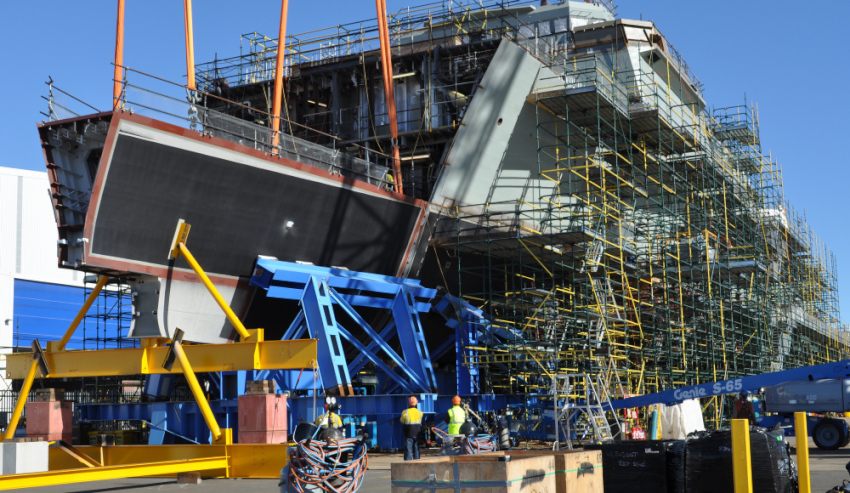Last week was busy for both industry and the Royal Australian Navy, with the next phase of the government’s $90 billion naval shipbuilding plan now underway.
To continue reading the rest of this article, please log in.
Create free account to get unlimited news articles and more!
Focus has shifted from the Air Force following the successful arrival of the F-35 on Monday last week to the Royal Australian Navy, in what has undoubtedly been one of the most groundbreaking weeks in the service's history following a number of major announcements and program updates.
As part of the government's $90 billion naval shipbuilding and sovereign industry capability plans, the Royal Australian Navy will undergo its largest modernisation and capability expansion since the Second World War.
Major projects totalling about $88.5 billion across the SEA 1180 Offshore Patrol Vessel (OPV), SEA 5000 Hunter Class frigates and SEA 1000 Attack Class submarines will transform the Navy's capability and support the development of Australia's sovereign shipbuilding capacity over the next three decades.
The past week has marked a number of major program milestones as part of the Navy's unprecedented period of modernisation and expansion.
Shipyard construction kicks off
Australia's future frigates and submarines require an immense amount of infrastructure to support the initial construction phases and through the critical maintenance and sustainment cycles, which ensure that the platforms remain combat capable throughout the life cycle of the platforms.
As the centre for Australia's $95 billion shipbuilding program, the ASC shipyards at Osborne in South Australia will undergo a series of modernisation and expansion programs, which were announced by the Minister for Defence Christopher Pyne late last week.
On Thursday, Minister Pyne officially turned the first sod at the future site of the submarine shipyard, which will be responsible for building Australia's future fleet of 12 Attack Class submarines from the 2020s.
Minister Pyne said, "An Australian continuous naval shipbuilding capability will see the creation of thousands of jobs across Australia over coming years, hundreds of which are construction and infrastructure roles based at the Osborne Naval Shipyard."
Senator Mathias Cormann, Minister for Finance and the Public Service, took part in the official ceremony and welcomed the ground breaking milestone in the $50 billion SEA 1000 program.
Minister Cormann said the government’s decisions to establish Australian Naval Infrastructure (ANI) and purchase land and facilities from the SA government in 2017 have enabled work to progress rapidly.
"The investment we have made through ANI will support a sustainable, long-term naval construction industry in Australia," Minister Cormann said.
Following on from this, both ministers announced the beginning of construction at the $535 million Osborne South facility, which will be responsible for building the Hunter Class future frigates.
"The steel raising for the new shipyard involves the elevation of more than 8,000 tonnes of structural steel fabricated by local South Australian companies, Samaras Structural Engineering and SA Structural Steel, two of the 58 local suppliers involved in this project," Minister Pyne said.
"It’s estimated the $535 million Osborne South project will create up to 600 jobs."
Minister Cormann reinforced the comments made by Minister Pyne, welcoming the news and support for Australian industry, noting that about 89 per cent of the steel used in the project would be Australian made.
"Progress at the Osborne South Shipyard is critical to ensure we meet our ambitious timeline to start the frigate program in 2020," said Minister Cormann.
Strategic partnering agreement progress means all ahead full for subs
Minister Pyne also took the opportunity to announce that the formal strategic partnering agreement (SPA) between the Commonwealth and SEA 1000 submarine designer Naval Group had been finalised, clearing the path for further design work to continue ahead of the formal signing early in 2019.
"I can also announce the negotiations between the Commonwealth and Naval Group on all key provisions of the SPA have been completed. I congratulate everyone involved in achieving this significant milestone," Minister Pyne said.
"Work on the design of the Future Submarines will continue without interruption under the design and mobilisation contract, which was signed on 30 September 2016."
The full range of other activities required to deliver this major program, including the development of the submarine construction yard, and the ongoing engagement of Australian industry to achieve Australian sovereignty, are also continuing.
Fair winds and following seas for HMAS Attack and all who follow her
Australia's fleet of future submarines officially have a class name and first of class. The vessels will be known as the Attack Class, with the lead vessel to be known as HMAS Attack when it enters service with the Royal Australian Navy in the early 2030s.
The Attack Class submarines will be delivered as part of the $50 billion SEA 1000 program, which will see Naval Group deliver 12 regionally superior submarines to the Royal Australian Navy.
Naval Group's successful Shortfin Barracuda design, which serves as the basis for the new Attack Class, is a conventionally powered variant of the nuclear powered Barracuda fast attack submarine currently under construction in France for the French Navy.
The Attack Class vessels will begin replacing the ageing Collins Class vessels at a time when 50 per cent of the world's submarines will be operating in the Indo-Pacific region.
Chief of Navy, Vice Admiral Michael Noonan, said the Attack Class would provide Australia with a regionally superior submarine.
"The name Attack along with its motto ‘Never Waver’ captures the tradition of tenacity and determination within the Australian submarine service," VADM Noonan said.
Minister Pyne welcomed the announcement, saying, "The Attack Class represents the inherent stealth, long-range endurance and lethality of a submarine."
Each of these major shipbuilding and capability acquisition programs represent a major step change in the way Navy does business. Like the F-35 for the Air Force, these platforms and supporting manufacturing and sustainment infrastructure will play a critical role in the ADF's transition to an integrated 'joint force' capable of distributed lethality well into the 2050s.

 Login
Login







